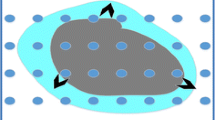Abstract
We examine the problem of tracking dynamic boundaries occurring in natural phenomena using range sensors. Two main challenges of the boundary tracking problem are energy-efficient boundary estimations from noisy observations and continuous tracking of the boundary. We propose a novel approach which uses a regression-based spatial estimation technique to determine discrete points on the boundary and estimates a confidence band around the entire boundary. In addition, a Kalman Filter-based temporal estimation technique is used to selectively refresh the estimated boundary to meet the accuracy requirements. Our algorithm for dynamic boundary tracking (DBTR) combines temporal estimation with an aperiodically updated spatial estimation and provides a low overhead solution to track boundaries without requiring prior knowledge about the dynamics of the boundary. Experimental results demonstrate the effectiveness of our algorithm and estimated confidence bands achieve loss of coverage of less than 2 − 5% for a variety of boundaries with different spatial characteristics.
Preview
Unable to display preview. Download preview PDF.
Similar content being viewed by others
References
Akyildiz, I.F., Su, W., Sankarasubramaniam, Y., Cayirci, E.: Wireless sensor networks: a survey. Elsevier Journal of Computer Networks 38, 393–422 (2002)
Nowak, R., Mitra, U.: Boundary Estimation in Sensor Networks: Theory and Methods. In: Zhao, F., Guibas, L.J. (eds.) IPSN 2003. LNCS, vol. 2634, Springer, Heidelberg (2003)
Ding, M., Chen, D., Xing, K., Cheng, X.: Localized Fault-Tolerant Event Boundary Detection in Sensor Networks. IEEE INFOCOM 2, 902–913 (2005)
Hsieh, C.H., Jin, Z., et al.: Experimental validation of an algorithm for cooperative boundary tracking. In: Proc. of American Control Conference (2005)
Zink, M., Westbook, D., Abdallah, S., Horling, B.: Meteorological command and control: An end-to-end architecture for a hazardous weather detection sensor network. In: EESR. Workshop on End-to-End, Sense-and-Respond Systems, Applications, and Services (2005)
Utkin, A.B., Lavrov, A.V., Costa, L., Simoes, F., Vilar, R.: Detection of Small Forest Fires by Lidar. Applied Physics B 74, 77–83 (2002)
Lavrov, A., Vilar, R.: Application of lidar at 1.54 μm for forest fire detection. Remote sensing for earth science, ocean, and sea ice applications 3868, 473–477 (1999)
Duttagupta, S., Ramamritham, K., Kulkarni, P.: Tracking dynamic boundaries using sensor networks. In: IIT Bombay, CSE department Technical Report TR-CSE-2007-7 (2007)
Duttagupta, S., Ramamritham, K., Ramanathan, P.: Distributed Boundary Estimation using Sensor Networks. In: The 3rd IEEE Conf. on Mobile Ad-hoc and Sensor Systems (2006)
Härdle, W.: Applied Nonparametric Regression. Cambridge University Press, Cambridge (1990)
Gasser, T., Kneip, A., Kohler, W.: A Flexible and Fast Method for Automatic Smoothing. Journal of the American Statistical Association 86(415), 643–652 (1991)
Levis, P., Lee, N., Woo, A., Welsh, M., Culler, D.: TOSSIM: Accurate and scalable simulation of entire tinyos applications. In: Sensys. Proc. of 1st ACM Conf. on Embedded Networked Sensor Systems (November 2003)
Guestrin, C., Bodik, P., Thibaux, R., Paskin, M., Madden, S.: Distributed Regression: an Efficient Framework for Modeling Sensor Network Data. In: IPSN (2004)
Deshpande, A., Guestrin, C., Madden, S., Hellerstein, J.M., Hong, W.: Model-based Approximate Querying in Sensor Networks. VLDB Journal (2005)
Liu, J., Chu, M., Liu, J.: Distributed State Representation for Tracking problems in Sensor Networks. In: IPSN (2004)
Coates, M.: Distributed Particle Filtes for Sensor Networks. In: IPSN (2004)
Manfredi, V., Mahadevan, S., Kurose, J.: Switching Kalman Filters for Prediction and Tracking in an Adaptive Meteorological Sensing Network. In: SECON. IEEE Conference on Sensor and Ad Hoc Communications and Networks (2005)
Liao, P., Chang, M., Kuo, C.J.: Contour Line Extraction with Wireless Sensor Networks. In: IEEE Conference on Communications (2005)
Singh, A., Nowak, R., Ramanathan, P.: Active Learning for Adaptive Mobile Sensing Networks. In: IPSN (2006)
Author information
Authors and Affiliations
Editor information
Rights and permissions
Copyright information
© 2008 Springer-Verlag Berlin Heidelberg
About this paper
Cite this paper
Duttagupta, S., Ramamritham, K., Kulkarni, P., Moudgalya, K.M. (2008). Tracking Dynamic Boundary Fronts Using Range Sensors. In: Verdone, R. (eds) Wireless Sensor Networks. EWSN 2008. Lecture Notes in Computer Science, vol 4913. Springer, Berlin, Heidelberg. https://doi.org/10.1007/978-3-540-77690-1_8
Download citation
DOI: https://doi.org/10.1007/978-3-540-77690-1_8
Publisher Name: Springer, Berlin, Heidelberg
Print ISBN: 978-3-540-77689-5
Online ISBN: 978-3-540-77690-1
eBook Packages: Computer ScienceComputer Science (R0)




